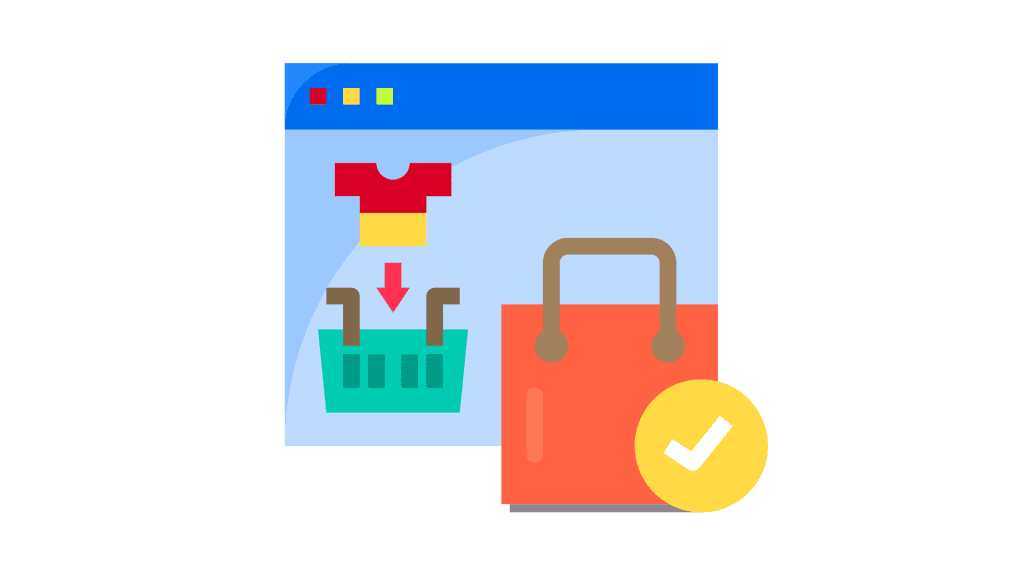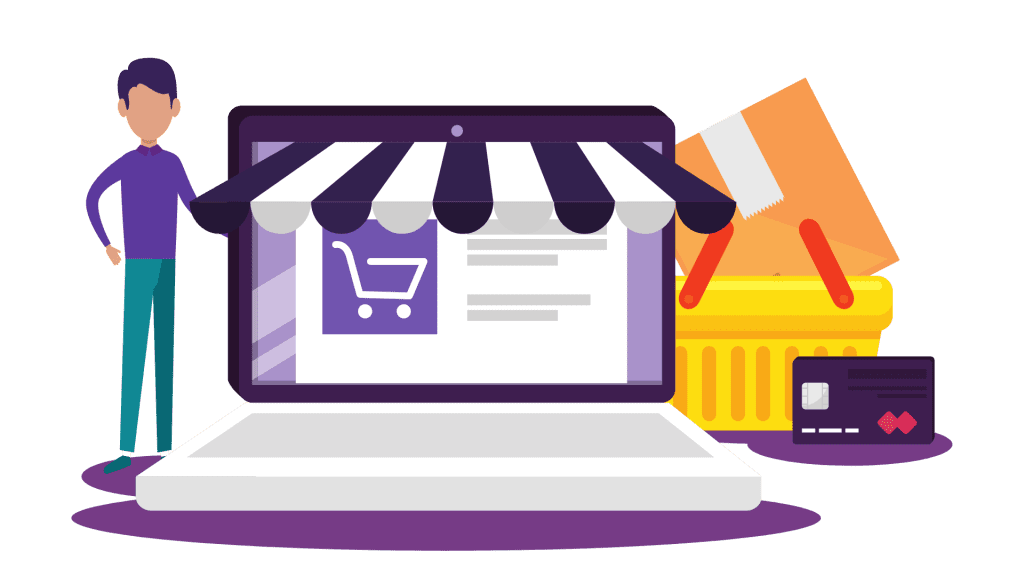The Ultimate Ecommerce Marketing Guide
- July 7, 2021

There’s a lot of potential for success when you run an ecommerce store, especially now, when more people than ever before are buying online. But of course, while the online sales market share is growing all the time, it’s also true that there’s plenty of competition. As much as you’d like it to be otherwise, the fact of the matter is that you won’t be the only company offering your products and services. There will be others. As such, your ongoing success will depend on your ability to get visitors to your website.
The good news is that you have a variety of tactics at your disposal for achieving this goal. In this ecommerce marketing guide, we’re going to run through everything you need to know about getting traffic to an ecommerce store. We’ll look at choosing the right CMS for your business, along with selecting the best marketing channel(s). Take our advice on board, and it won’t be long before you notice an increase in the number of people visiting your website.
How to Choose an Ecommerce CMS

You’ll find it much easier to get visitors to your site if all the different components are watertight. To do this, you’ll need a CMS, which stands for Content Management System. A good CMS won’t just allow you to easily design a beautiful, user-intuitive site, but also to track all the key data — including what’s working, what isn’t, and more. It’s a fundamental tool that’ll allow you to create a website that truly works for you and your visitors. There are plenty of options to choose from, but the two biggest are Shopify and WooCommerce. Let’s take a closer look at both.
Shopify

Shopify has built a great reputation among ecommerce store owners. It’s useful for both experienced shop owners and newcomers to the game.
What are the pros and cons of a Shopify Store?
There are a whole host of plugins that can help you to get the most from your Shopify store. The best ones aim to get rid of the headaches that online buying can induce. For example, there’s Free Shipping Bar, that lets your visitors know that, well, you offer free shipping. Returnly is also handy — it streamlines the returns and exchanges process, which has long been an issue for store owners and consumers.
Best Shopify Plugins
There are a whole host of plugins that can help you to get the most from your Shopify store. The best ones aim to get rid of the headaches that online buying can induce. For example, there’s Free Shipping Bar, that lets your visitors know that, well, you offer free shipping. Returnly is also handy — it streamlines the returns and exchanges process, which has long been an issue for store owners and consumers.
Costs
So what will you pay to use Shopify? There’s a 14-day trial that’ll allow you to see what all the fuss is about, without commitment. After that, there are three payment levels: Basic Shopify for $29/month, Shopify for $79/month, and Advanced Shopify for $299/month.
WooCommerce

WooCommerce is an offering from WordPress, which is a badge of assurance in its own right. It’s designed for use for all companies, from small companies to large, and has built a loyal following thanks to its ease of use and ability to customise.
What are the pros and cons of a WooCommerce Store?
Pros include the speed at which you can get set up. If you have a website already, especially a WordPress site, then you can be up and running in no time at all. It’s also highly affordable, making it an attractive option for small business owners, and there’s also plenty of tools that’ll help you to maximise performance.
There aren’t many downsides, but if we were going to be picky, we’d say that the design isn’t quite as advanced as other tools, and sometimes the load speed can be a little slow. But they’re minor faults.
Best WooCommerce Plugins
You’ll need some plugins to get the most from WooCommerce. One of the best is YITH WooCommerce Wishlist, which allows visitors to create a favourite products list. A great way to build loyalty and encourage people to buy! PickPlugins Product Slider is also recommended; it allows you to showcase your products in an engaging way.
Costs
At the most basic level, WooCommerce is free. But to get any real use from it, you’ll need to buy extras, such as a domain name and hosting service. They cost, together, around $15 – 25 a month. Themes and plugins also cost extra.
Did you know that we have a dedicated WooCommerce SEO service?
Marketing Channels

Now that you have chosen a Content Management System, you need to select the correct channels to generate traffic to your store.
SEO
What is SEO?
SEO stands for Search Engine Optimisation, and it is vitally important for the success of an ecommerce website; indeed, for any website. Through the process of improving your SEO, you’ll make your site more visible on search engines such as Google.
Benefits of SEO for Ecommerce
There are many benefits, but the most important one is that your site will be found more easily by Google. And that ultimately means that more people will see — and hopefully visit — your website.
Step by step to getting started with SEO
SEO sounds complicated, but it’s not really. It is, however, a process. You’ll want to factor in all of the below into your SEO task.
On-page SEO

1. Keyword research
People can’t find you if you’re not using Google-friendly terms. When it comes to writing your copy, you’ll need to know what words to use. Keyword research is the act of identifying the words that people who are looking for your products/services use on Google.
2. Meta titles/descriptions
Your meta titles and descriptions will be what people see when they encounter your site on Google. Make sure they’re the optimal length and include your USP — you need to incentivise people to click.
3. Copy length
Google doesn’t like walls of texts, because customers don’t like walls of text. Keep your text short and snappy. It should be informative, but also concise.
4. Optimise click-through rate
It’s one thing to be on the first page of Google. It’s another to have people click through. Make your copy stand out with attention-grabbing headlines and see your clicks rocket.
Technical SEO
1. Sitemap
A sitemap isn’t for your customers. It’s for the search engines. A well-thought-out sitemap will tell Google and co what’s on your site.
2. Site structure
Google likes to see solid organisation just as much as anyone else. Your site structure refers to the makeup of your site. For instance, you could have three levels: your homepage, your category pages, and your products.
3. Broken links/404 pages
There are no advantages to having broken links. It doesn’t look good and makes it more difficult for Google to crawl your website. Conduct periodic checks to ensure everything’s as it should be.
4. Site auditing
SEO rules change from time to time. Conducting a site audit will ensure that you’re always kept up to date with the latest and best practices.
5. Canonical tags
The search engines look for unique content; duplicate content will have a mark against it. Canonical tags help to eliminate duplicate content, and can only be seen by search engines.
6.Robots.txt
Robots.txt are useful robot-esque files that show search engines the right places to look on your website, and which parts of the site they should ignore.
7. 301 Redirects
If you’re moving your site elsewhere, then 301 redirects will ensure that the site’s SEO credentials are not lost during the transition.
8. Duplicate content
Duplicate content hurts search engine results. You can perform checks to identify and then remove duplicate content found elsewhere on the web.
9. Schema
Schema is a kind of internet language that structures data. Google loves it, because it keeps things organised, and in turn helps to return more detailed results.
Off-page SEO

1. Google My Business
You may be an ecommerce business, but you may also have one eye on the local market. Google My Business can greatly enhance your local search engine results.
2. Trustpilot
Trustpilot is at the cutting edge of consumer reviews, which Google laps up. Managing and maintaining your TrustPilot page can thus give your ecommerce store a big boost.
3. Link Building
Link building is a vastly important aspect of SEO. It’s the process of having other sites link to your page. You can do this by asking, guest posting for other sites, or having useful info on your site that others will want to link to.
User Experience

1. PageSpeed
If your website loads slowly, then people will be unlikely to stick around. And Google won’t like your site either. Perform periodic checks to ensure that your website loads quickly, across different devices and geographical zones.
Check your how fast your website is with Google PageSpeed Insights
2. Mobile-friendliness
If you’re only optimising your site for desktop visitors, then you’ll be missing out on a big chunk of potential customers. In recent years, mobile internet browsing has overtaken desktop browsing.
3. Customer service
Positive reviews and a happy customer experience boosts SEO. And you won’t be able to get them if you don’t have great customer service. Having reviews around the web is an incredible asset.
4. Checkout optimisation
Don’t lose customers because of a complicated checkout system. Make it easy. The search engines look for well-managed, easy to use websites. Your customers shouldn’t jump through hoops just to pay.
Top tip: consider using Apple Pay or Google Pay for a quick, easy checkout.
PPC
What is PPC?
PPC stands for Pay Per Click. It’s a type of internet advertising structure whereby the advertisers pay only when someone clicks on their link. It differs from organic growth in that this is paid growth. You’ll have seen PPC advertising at the top of Google results pages — those ads are PPC ads.
Benefits of PPC for Ecommerce
Ecommerce business owners use PPC because it works. It allows you to advertise within a set budget, reach highly targeted consumers (such as people searching for the products/services that you sell), and ensures that your website is seen. It’s a fast-track route to the top of the results page.
Step by step to getting started with PPC

1. Keyword Research
Just as with SEO, you’ll need to use the right words as part of your PPC campaign, if it’s going to be successful. There are various sections you should look at — including branded, product-specific, feature-specific, and high-intent keywords. Let’s take a look at these.
2. Branded
Branded keywords relate to your name and branding. For example, if you were, say, Nike, these keywords would be ‘Nike’ and ‘Just Do It.’
3. Product-specific
Product-specific keywords relate to whatever it is that you sell. If you were selling mobile phones, then they could be something like ‘iPhone SE’ and so on.
4. Feature-specific
Feature specific is a broad way of describing what you offer. For example, it could be football shoes or similar.
5. High-Intent keywords
High intent keywords refer to the terms that people use again and again, and widely. For example, it could be something like: ‘buy cheap iPhone.’
Optimise Paid Shopping Ads

Google Shopping
You’ll advertise differently on Google shopping than you would Amazon. You can optimise your ad by having tight copy, using negative words (words that are related but which you don’t want — for example, you sell Samsung phones; a negative word would be iPhone). Images and the right pricing will also help.
Amazon Marketplace
Keywords are arguably more important than Amazon PPC ads than any other platform. Write a well thought out and that uses keywords and a high-quality picture to give yourself a good chance for success.
Bing Shopping
Bing’s big thing is product attributes. They walk you through the key details that they need to know. Don’t leave any out!
Ad Extensions
Sitelinks
Sitelinks ensure that people end up at the page you want them to land on.
Location
Location extensions make it easier for people to find your business, in terms of geographical location, phone number, and more.
Call
Call extensions make it easy for a person to call you without going to their phone call application on their device.
Reviews
These applications allow you to include customer reviews in your ad.
App
If you have a mobile application, then these types of extensions can get them in front of relevant people.
Callout
Callout extensions allow you to highlight one specific aspect of your business within your ad.
Structured snippet
Structured snippets allow you to highlight the key details of your ad.
Landing page optimisation
Your landing page should be designed with intention. The goal is to dazzle the people who have clicked through, not waste their time.

What is email marketing?
Email marketing is just what it sounds like: marketing via email. Through the course of running your website, you’ll likely build an email list. From time to time, and in various ways, you can use this list to send out emails. It’s a popular and effective way to spread the word, especially since most people on your email list will already be interested in your product in some way.
Benefits of Email Marketing for Ecommerce
There are plenty of benefits to email marketing. One, it’s relatively low-cost. All you need to do is put together a good email campaign, and you’ll see results, without spending the earth. It also has a high conversion rate, perhaps because everyone on the list is already interested in your company. It’s also a highly customisable form of communication, which you can tailor to your needs.
The Best Way to Structure an Email for Ecommerce
GDPR
Audience lists/groups/segmentations
GDPR is not something that a company should take lightly. After all, there are big fines to be had if you’re in violation. One way people are in violation is by acquiring lists from elsewhere, such as buying the list or scraping it for a site. This could be tempting, but it’s against the law.
Subscribed/Unsubscribed/Cleaned/Non-Subscribed
Some people will sign up for your newsletter. But they won’t always want to stay on that list. It’s vitally important that you’re honouring people’s request to be unsubscribed from your email list as and when it happens. And of course, the only people on the list should be people who signed up in the first place.
Subject line
1. 4 Second test
The 4 second test refers to the amount of time that someone spends deciding whether to open an email or not. If it’s unclear what you’re saying or in any other way puts people off, then they’ll leave — they won’t spend any time thinking twice about it!
2. Keep it short
Save the bulk of your content for the inside part of the email. For the heading, keep things short and sweet. The more engaging that you can make it, the better — people won’t click inside if there’s nothing to entice them to do so.
3. Don’t mislead
It’s tempting to try to lure people into opening your email by using a misleading comment. But don’t do it. They’ll find out once they’re inside the email what has happened, and they won’t be happy. Remember that the end goal isn’t to get people to open the email, but to turn them into customers. And they won’t become customers if they’re annoyed at you for tricking them.
Email Design Considerations
1. Personalisation
People are a lot more likely to open an email if it feels like it has been addressed to them specifically. If you already have a lot of information about your customer at your fingertips, then why not use it? Simply beginning the email with their name will make it more likely that they open it.
2. Content marketing
There’s got to be something in your email of value. Rather than simply getting to the point — as in, whatever it is you’re hoping to get — make sure they’re getting something tip. Including engaging, useful content will make the email feel more like a conversation, rather than something you’re just shouting at the crowd.
3. Layout
The email layout is important because you don’t know how long people will spend looking at your email. The layout should push people to look at the most important details first. Also be mindful not to overload the email — the recipient should be able to scan read the whole thing.
4. Images
Nobody likes to stare at a wall of text, no matter what medium they’re looking at. You can make your emails more visually appealing by including relevant images. As with all other aspects of your content, it’s important that you’re sourcing high-quality photographs for use.
5. Fonts
Companies typically only use one type of font with their emails, but this could be a mistake. It’s generally best to use two — one for headings, and one for paragraphs.
6. Links
As we said earlier: having the person open the email isn’t the end game. You’ll hope that they’ll click through and visit your site. For that to happen, your email must have links. These should be hyperlinked where possible, but if it’s a simple text email, then adding the link in text form is also fine.
7. Width
It’s better for an email to be too narrow than too wide. Keep your maximum width at 640 px. That’ll be the size that’ll work with most email clients.
8. CTA
Your CTA – Call to Action — will be what prompts people to click through to your website. The design, placement, and text you use will all be vitally important.
Email Automation
1. Welcome email
When someone signs up for your newsletter, don’t wait until whenever you next send one out before you get in touch with them. A welcome email can go a long way — it’ll help them to learn a little more about who you are, what you can do for them, and so on.
2. Follow-ups
Sometimes, people need a bit of encouragement to become a customer. A follow up email is a great way to build on the good work that you’ve already done. It’s just a little reminder to the customer, who may have been busy in recent days. You can send these automatically.
3. Free trial/discount
Offering a free trial or discount is a great way to drum up some business, both from existing customers and newbies. The type of deal you offer will depend on who the customer is. A newbie could be offered a free trial. A veteran may receive a discount.
4. Sign up
When someone signs up for your website, you don’t need to send them a manual email. An automated sign up email will do that. This differs from the welcome email in that it simply recognises that they’ve joined your site — it’s almost like a receipt.
5. Purchases
Your customers should receive an automated message when they make a purchase.
6. Checkout
Many people abandon their shopping carts online. If you have the person’s details, then you could send an automatic reminder that they haven’t completed their purchase. It could be just the motivation that they need.
Social Media

What is social media marketing?
Social media marketing is just what it sounds like — marketing through social media!
Benefits of social media marketing
It allows you to reach an extremely large audience. You can also more easily connect with people who are in your target demographic.
What is Social Media Ecommerce Marketing
Organic Content
Images
Posting images that people engage with you, and which promotes your products, is an example of organic content.
Content optimisation
Creating high-quality, easily-found content can build your social media following and promote sharing.
Sharing content
Not all your content has to be unique. You can also share content from other users, providing it’s relevant.
Impressions
There’s a lot of insight available on social media. You’ll want to track, measure, and aim to improve the number of impressions your content receives.
Links
You don’t need to give away all your best content on social media. Include links to relevant pages on your website.
Videos
People love watching videos, so mix up your content by including high-quality videos.
Social Media Advertising
Brand Awareness
You can advertise on social media with the sole aim of raising brand awareness. This will be less about marketing one particular product, more about selling people on your company as a whole.
Target Audience
To advertise effectively, you’ll need to know who your target audience is. Once you have that, you can target your ads to be seen by them and them only.
PPC on Facebook is highly effective. Use high-quality images, excellent copy, and you can reach people at any stage of their customer cycle.
On Instagram, it’s all about images. It’ll be the visual aspect of your ad that does the bulk of the work, so make sure they look good.
YouTube
YouTube marketing is a little different. You can build a following by publishing useful, informative videos. It’s more like content marketing.
All types of companies can take advantage of Pinterest’s ad capabilities, which has become more advanced in recent years.
You can build your LinkedIn reputation by publishing great content — and having your employees do the same.
Content Marketing

What is content marketing?
Content marketing is a kind of advertising in disguise. Rather than obviously marketing one product or service, it attracts people through the use of valuable, useful content. A blog post that runs through how to use a product effectively would be an example.
Benefits of content marketing
There are many benefits to content marketing. It provides value to customers, establishes a company as leaders, and helps to build trust, among others.
Optimising Content Marketing for Ecommerce
Organic Content
For your content to be useful, it has to be written with the target audience in mind. So when you’re putting together your content, think about who you’re trying to reach. Creating a buying persona can keep you on the right track. How old are they? What is their background, and what are their interests?]
Content structure
If you’re writing a blog post, putting together a video, or producing any other type of content for marketing purposes, then it’s a good idea to follow a tried and tested structure. This structure is as follows:
- Intro
- Main Body
- Solution
- Conclusion – CTA
This will help to create an engaging and useful piece of content.
Linking
Internal links
Including internal links to other pages on your site can help the visitor and also improve your SEO.
External links – open in new tab
External links to other credible sites will help SEO, but just be sure that the links open in new tabs. You don’t want people to leave your site!
DoFollow and NoFollow links
You’ll have other people linking to your site from time to time. These can be useful, but only if the linking site is credible. If they are, then they should be given the DoFollow tag. If they’re spam/low-quality, then NoFollow is the way to go.
Best tools
SEMRush
SEMRush is a digital tool that allows companies to put together effective digital campaigns. It has a host of features that can tell you if you’re on the right track.
Grammarly
Don’t spoil your content with grammar and spelling errors. Grammarly will flag up any mistakes.
Buzzsumo
Buzzsumo can help you to come up with ideas for your content by showing you what topics are currently popular on the web.
Ahrefs
Ahrefs will help you to manage your backlinks, as well as providing many other useful SEO tools.
Do’s and Dont’s
Strong CTA
Any content you produce should lead somewhere. A strong CTA will yield the best results.
Contact forms
Good content is all about engagement, so allow your visitors to get in touch with you.
Internal links
Internal links will boost your SEO and make it easier for your visitors to navigate your site.
Avoid long titles
Everything should be short and snappy. People don’t have that much time!
Keywords
The odd keyword is fine, but keyword stuffing is an outdated practice that’ll hurt more than help.
Looking to excel your Ecommerce store? Get in touch today
Contact Us
Cheshire (Head Office)
Manchester
Get in touch
Let’s find the best solution for your business



